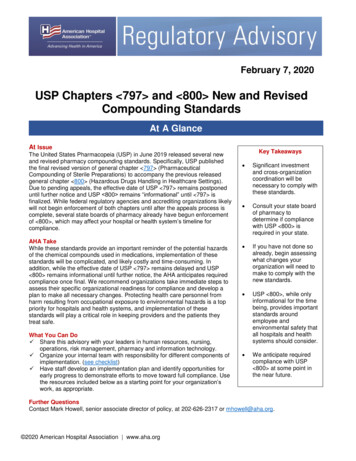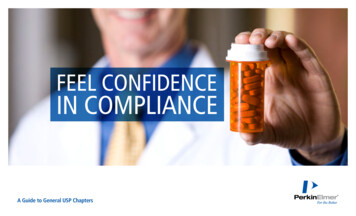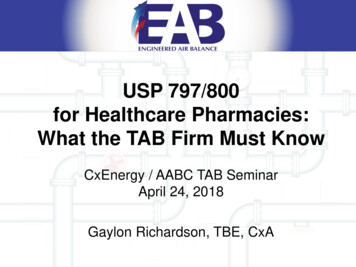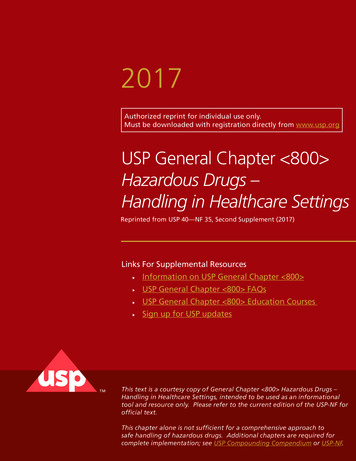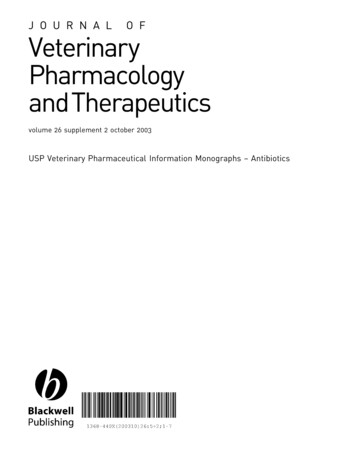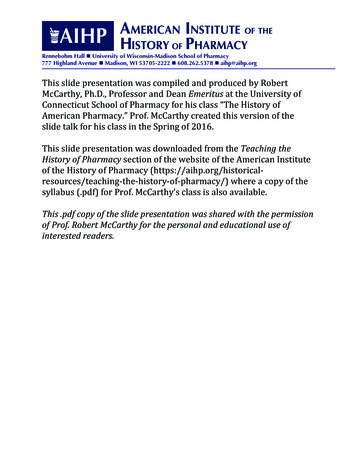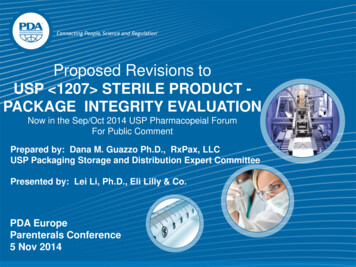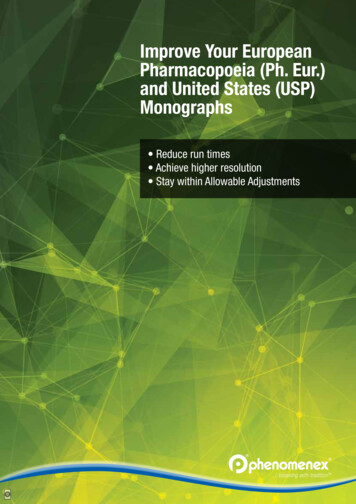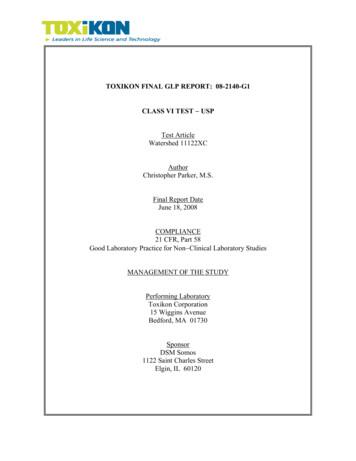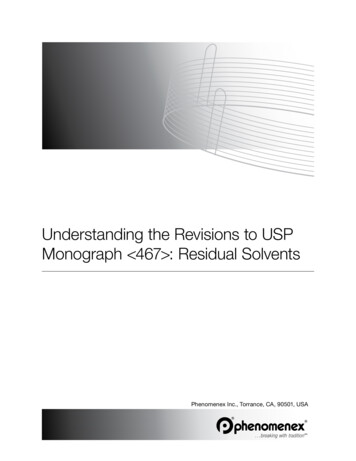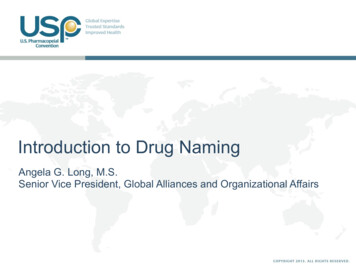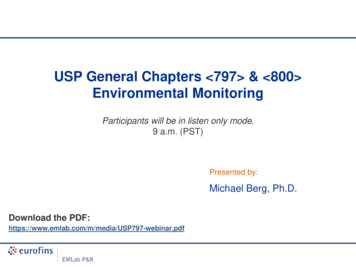
Transcription
USP General Chapters 797 & 800 Environmental MonitoringParticipants will be in listen only mode.9 a.m. (PST)Presented by:Michael Berg, Ph.D.Download the df
Continuing Education Units (CEUs)To receive a certificate ofattendance, you must completethe survey after the webinar:Click on the survey link in the“Thank you” email. (sent 1 hourafter this webinar) Complete survey within 24 hours. You will receive an email in 2-3weeks when your certificate is ready.
Outline Introduction to general chapter USP 797 Personnel training Environmental monitoring and sampling Investigation of excursions and remediation USP 800 – Handling of hazardous drugs in healthcarefacilities
Revision of Chapters 795 , 797 & 800 Update on Appeals Panel DecisionGeneral Chapters 795 and 797 The Appeals Panel has granted the appeals to General Chapters 795 and 797 and is remanding the chapters to the Compounding Expert Committee(CMP EC) with the recommendation for further engagement on the issuesraised concerning the beyond-use date provisions.Implications:The currently official chapters of 795 (last revised in 2014) and 797 (last revisedin 2008) remain official.General Chapters 800 The new General Chapter 800 was made official on December 1st, 2019. 795 Pharmaceutical Compounding ‒ Nonsterile Preparations 797 Pharmaceutical Compounding ‒ Sterile Preparations 800 Hazardous Drugs ‒ Handling in Healthcare Settings4
What is USP 797 ? USP-NF establishes standards for medicines, food ingredients and dietarysupplements. General Chapter USP 797 establishes best practices and regulations forthe production of compounded sterile preparations.MonographsGeneral ChaptersGeneral NoticesMonographs includes the name of the ingredient orpreparation; the definition; packaging, storage, andlabeling requirements; and the specification.General Chapters establish procedures,methods and practices.General Notices help with theinterpretation of USP–NFstandards5
Abbreviations and TermsAbbreviations:Terms:USP-NF: United States Pharmacopeia –National FormularyClean RoomBuffer AreaCSP: Compounded Sterile PreparationAnte AreaPEC: Primary Engineering ControlsAseptic ProcessingBUD: Beyond Use DatingPreparationDCA: Direct Compounding AreaProductCAI: Compounding Aseptic IsolatorBSC: Biological Safety Cabinet6
USP General ChaptersGeneral Chapters in the USP-NF Numbered below 1000 Compendium and discretionary State requirements Made applicable through general notices, monographs or anotherapplicable general chapters below 1000 Numbered 1000 to 1999 Informal chapters Numbered 2000 and above Dietary supplements7
Sterile CompoundingSterile compounding is combining, diluting, pooling, reconstituting or otherwise altering a drugor bulk drug substance to create a sterile preparation.This includes: Altering the dosage form or delivery system of a drug Altering the strength of a drug Combining components or active ingredients Preparing a drug product from chemicals or bulk drug substancesUSP 797 applies to all persons who prepare and all places wherecompounded sterile preparations (CSPs) are made for humans or animals.8
Compounded Sterile PreparationsExamples of CSPs: Injections Total Parenteral Nutrition (TPN) Preparations for pulmonary inhalations Baths and soaks for live organs and tissues Irrigations for internal body cavities Implants9
Scope of USP 797 Practices out of Scope for USP 797 Sterile radiopharmaceutical compounds – USP 825 Preparations per approved product labelling Single dose, single patient Labeling must include diluent, strength, storage time, container closure system Immediate use CSPs Single patient – prepared from not more than three different sterile productsUnused medication from a single dose vial must be discardedAdministration must begin within four hoursMust be appropriately labelled if not administered by preparer10
Cleanroom DesignAnte RoomISO 7PEC (ISO 5)ISO 8Buffer Room11
Cleanroom: Hazardous CompoundingAnte RoomISO 7PEC (ISO 5)ISO 7Buffer Room12
Mission of Chapter 797 Goal of USP 797 :Minimize harm, including death to humans and animals that couldresult from Microbial contamination (non-sterility)Excessive bacterial endotoxinsVariability from the intended strength of active ingredientsPhysical and chemical incompatibilitiesChemical and physical contaminantsUse of ingredients of inappropriate quality13
Revision – Risk CategoriesRisk categories (low risk, medium risk and high risk compounding) havebeen collapsed in the new revision. However, the 2008 version remainsofficial at this timeLow RiskMedium RiskHigh RiskNo more then 3 sterileproductsComplex manipulationsProduced with non-sterilecomponents or processexposed to worse thanISO5 for 1 hrCSPs administeredwithin 48 hrs (RT), 14days (refrigerated), 45days (frozen)CSPs administered tomore then one patientor same patient multipleoccasionsBUD: 30 hrs (RT), 9days (ref.), 45 days(frozen)Requires terminalsterilizationBUD: 24 hrs (RT), 3 days(ref.), 30 days (frozen)Immediate and emergency use CSPs are not subject to same requirements14
Personnel TrainingAny person handling CSPs and/or accessing the compounding areamust be trained A designated person is responsible for overseeing the training program Visual observation, training and testing of compounding personnel maybe performed by A designated person or an assigned trainerWritten training program including: Specifics of required competenciesFrequency of trainingProcess for evaluating competenciesVisual observation, written or electronic testDocumentation of training results15
Personnel Training (cont’d)Personnel must demonstrate and be tested for core competenciesinitially and every 12 months in: Hand hygiene Use of equipment Garbing Documentation of compounding process Cleaning and disinfection Principles of HEPA-filtered unidirectional Calculations, measuring and mixing Aseptic technique Achieving and/or maintaining sterilityand apyrogenicityairflow within the ISO 5 area Proper use of primary engineeringcontrols (PECs) Principles of movement of materials andpersonnel within the compounding area16
Personnel Training – Microbial TestingGloved fingertip testing Press all fingers of one hand including thumb on a media plate (e.g.TSA w/ polysorbate 80 & lecithin) after performing hand hygiene andgarbing procedure. Initial qualification – three times with no growth on either plate (leftand right hand). Continued qualification – testing every 6 months with a maximum of3 cfu for both hands combined. Isolator box: test sterile gloves placedover the equipment gloves.17
Personnel Training – Microbial Testing (cont’d)Media fill testing Simulation used to qualify processes and personnel engaged in sterilecompounding to ensure that the processes and personnel are able toprepare CSPs without contamination. Initial qualification and every 6 months thereafter. Replace ingredients with soybean-caseindigest medium (TSB) and perform mostchallenging procedures that the traineemay encounter. Media fill test kits may be used.18
Personnel Training – SummaryTraining ModuleFrequencyThresholdTesting of all corecompetenciesEvery 12 monthsObservation, test scores,etc.Gloved fingertip testing1Every 6 monthsZero cfu initially (3 times), 3 cfu for continuousqualificationMedia fill testing2Every 6 monthsNo growth1Incubation 30 C to 35 C for no less than 48 hours (2008 version)2Incubation 20 to 25 or at 30 to 35 for a minimum of 14 days (2008 version)19
Facility Design and Environmental MonitoringSterile compounding facilities must be designed, outfitted, andmaintained properly to minimize the risk of contamination of CSPs.Required air quality for various areas is achieved via: Facility design Primary engineering controls (PECs) Secondary engineering controls (SECs) HEPA filtration, ventilation, air flow20
Cleanroom DesignCleanroom suite ISO-classified ante-room and buffer room is separated from thesurrounding unclassified areas of the facility. Air flow - specific design and monitoring required. Ante room with line of demarcation for clean and dirty area or two anterooms required.Segregated compounding area (SCA) PEC may be located within an unclassified area, without an ante-roomor buffer room. Must be located away from windows, doors, traffic etc. which mayadversely affect air quality.21
Air quality – Cleanroom SuiteAnte RoomPEC (ISO 5)ISO 8Buffer RoomISO 7Total Particle CountsISOClassDirect Compounding Area0.1 µm0.2 µm0.3 µm0.5 µm1 µm5 µmFED STD 209ClassISO 1102ISO 210024104ISO 31,0002371023581ISO 410,0002,3701,0203528310ISO 5100,00023,70010,2003,52083229100ISO 61,000,000237,000102,00035,2008,3202931000Buffer RoomISO 7352,00083,2002,93010000Ante RoomISO 83,520,000832,00029,300100000ISO 935,200,0008,320,000293,00022
Air flow (2008 revision)For rooms providing a physical separation through the use ofwalls, doors, and pass-throughs, a minimum differentialpositive pressure of 0.02- to 0.05-inch water column isrequired. No less then 30 ACPH for buffer and ante rooms.23
Air FlowAir change requirements for SECs in new revision (2019)Compounding AreaUnclassified SCAAir Change Per Hour (ACPH)No requirementISO class 7 room(s) 30 ACPHISO class 8 room(s) 20 ACPH In a cleanroom suite the minimum positive differential pressurefrom cleanroom classification with higher quality to the next (e.g.ISO7 to ISO8) must be at least 0.02 inch water column. Pressure differential must be monitored, recorded and reviewed.24
Air Monitoring – Total Particle CountISO 14644: Rule of thumb: # samples Square Root of the cleanroom area, at least 1 minute & 2 Liters / sampleArea [m2] less thanor equal toMinimum # ofsamples locations(90% confidencelevel)21105328561110416190215002625
Air Monitoring of Viable Particles Air sampling in each classified area every 6 months(same frequency as certification of PEC) Volumetric sampling under dynamic conditions: 1000 liters minimum for all areas 2008 version: 400 to 1000 liters During typical operating conditions every six months. Use general microbiological growth medium (e.g. TSA).26
Air SamplingIn addition to routine air monitoring every 6 months testing is alsoperformed In conjunction with the certification of new facilities and equipment After any servicing of facilities or equipment In response to identified problems (e.g., positive growth in sterility testsof CSPs) In response to identified trends (e.g., repeated positive gloved fingertipand thumb sampling results, failed media fill testing, or repeatedobservations of air or surface contamination) In response to changes that could impact the sterile compoundingenvironment (e.g., change in cleaning agents)27
Air Sampling – Media and IncubationMedia:“A general microbiological growth media that supports the growth ofbacteria and fungi must be used (e.g., TSA).”For high risk compounding use fungal media (e.g., MEA) in addition.Incubation:30 C to 35 C for 48 to 72 hours (TSA)26 to 30 for 5 to 7 days (MEA).28
Air Sampling ThresholdsAction levels for classified areas (USP 797 )ISO ClassAir Sampling Action Levels(CFU/m3)*5 17 108 100* All action levels must be based on sampling in the vicinity ofexposed materials/articles during compounding operations.29
Surface SamplingSurface sampling routinely (typically done with air sampling and/orpersonnel qualification testing). All classified areas and pass-through chambers connecting to classifiedareas including The interior of the PEC and the equipment contained in it Staging or work area(s) near the PEC Frequently touched surfacesWhen conducted, surface sampling must be performed at the end ofcompounding activity or shift, but before the area has been cleaned anddisinfected.30
Surface Sampling (cont’d)Contact Plates or Paddles (24 – 36 cm2) Easy to use Accurate Less handlingSwabs Can sample curved surfaces Convenient Less expensive31
Surface Samples – Media and IncubationMedia:A general microbiological growth media that supports the growth ofbacteria and fungi (e.g., TSA) containing neutralizing additives (e.g.,lecithin and polysorbate 80). For high risk compounding use fungalmedium (e.g., MEA) in addition.Incubation:30 C to 35 C for 48 to 72 hours (TSA)26 to 30 for 5 to 7 days (MEA).32
Surface Sampling ThresholdsAction levels for classified areas (USP 797 )Surface samplingISOClassUSP 797 2008 Revisioncfu per sampleUSP 797 2019 Revisioncfu per sample5 3 37 5 58 100 5033
2019 Revision – Summary of ChangesChanges concerning Environmental Monitoring Sample volume: At least 1000 liters (previously 400 – 1000 liters). Frequency of testing: Surface testing changes from “periodically” tomonthly requirement. Media and incubation: Default becomes dual incubation of onesampling plate (e.g., TSA); alternatively the use of 2 media plates perlocation is allowable. Genus identification: Identifications to at least genus level are nolonger required for samples with counts below the thresholds for colonycounts. Threshold levels: Remain largely the same with the exception of ISO8surface samples (2019 revision 50 cfu per sample).34
Data Evaluation and Remediation Evaluate cfu counts against action levels (air and surface). Examine counts in relation to previous data and trends. If levels exceed thresholds an attempt must be made toidentify any microorganism recovered to the genus level (currentversion requires all colonies to be identified and correctiveaction for any “highly pathogenic” organisms). Implement and document corrective action plan (e.g., facilityimprovements, personnel training, cleaning and disinfection,HEPA filter replacement).35
Cleaning and DisinfectionSiteCleaning &DisinfectionSporicidalApplicationRemovable work tray of PECDaily*MonthlyPass through(s)DailyMonthlyWork surfaces (outside PEC)DailyMonthlyFloor(s)DailyMonthlyWall(s), door(s) and door age shelfing and binsMonthlyMonthlyEquipment outside PECMonthlyMonthly* Work surface daily, underneath work surface monthly36
Cleaning and Disinfection (cont’d)Cleaning and disinfection inside PEC and equipmentinside PEC Clean and disinfect all interior surfaces of the PECdaily and when surface contamination is known orsuspected. Apply sterile 70% IPA to the horizontal work surface atleast every 30 minutes or after compounding iscompleted. Apply sporicidal agent monthly.37
DocumentationDocumentation is Key to Providing Good USPServices Copy or original certificate of sterility Equipment calibration and training certificates Maps to indicate environmental samples Document time of sampling also in reference to otheractivities Records for cleaning activities, investigations, results ofmonitoring 38
General Chapter USP 800 Chapter 800 builds on thestandards established by othercompounding chapters 795 PharmaceuticalCompounding – NonsterilePreparations 797 PharmaceuticalCompounding – SterilePreparationsAdds the element of containment ofhazardous drugs39
USP 800 Purpose to promote patient safety, worker safety and environmentalprotection.Scope applies to all healthcare personnel who handle (store, prepare,transport and administer) hazardous drugs (HD).Intended use pharmacists, pharmacy technicians, nurses, physicians, physicianassistants, home healthcare workers, veterinarians, and veterinarytechnicians.40
AbbreviationsHD: Hazardous DrugACPH: Air Changes Per HourC-SCA: Containment Segregated Compounding AreaC-PEC: Containment Primary Engineering ControlC-SEC: Containment Secondary Engineering ControlCSTD: Closed System Drug-Transfer DeviceCACI: Compounding Aseptic Containment IsolatorCVE: Containment Ventilated EnclosureAPI: Active Pharmaceutical Ingredient41
HD ExposureExposure applies to allhealthcare personnel PharmacyTechniciansNursesExposure also applies toall healthcare entities Veterinarians &TechniciansHomeHealthcare WorkersPatientTreatment ClinicsStorageFacilities
Types of ExposureSome activities that may result inexposure can include Opening hazardous drug orders Crushing tablets or opening capsules Expelling air from syringes filled withHandling usedsyringesCrushing and/oropening tabletshazardous drugs Administering hazardous drugs whetherintravenous, epidural or oral Handling hazardous drugs during thepreparation or cleaning process Maintenance activities of potentiallycontaminated equipment and devicesAdministeringhazardous drugsCleaning upHD spills43
Controlling ExposureTwo principles of safetyContainment Separate, fixed walls Negative PressureDilution External ventilation Air Changes Per Hour (ACPH)44
Primary Engineering ControlsBiological Safety Cabinet(BSC)Compounding Aseptic ContainmentIsolator (CACI)45
Non-Sterile HD CompoundingC-PEC(CVE or BSC)Compounding Engineering ControlsC-SEC Requirements Physically separatedNegative pressure for HD Externally vented (or redundant HEPAfilters in series)Air exchange: 12 ACPH Negative pressure between 0.01 – 0.03”wc relative to adjacent areas46
Sterile HD CompoundingNon-HDCompoundingHD CompoundingC-PEC(BSC II or CACI)Ante-room ISOClass 7Buffer-roomISO Class 7PEC(LAFW or CAI)Buffer-roomISO Class 7Sterile Compounding – Clean RoomAnte-room Requirements Minimum of 30 ACPH of HEPA filtered air Positive pressure ISO Class 7 or betterExample only: various setup options possible47
Hazardous DrugsHD What are we talking about?American Society of HospitalPharmacists (ASHP) (1990)GenotoxicityNational Institute for OccupationalSafety and Health (NIOSH) ratogenicity or fertility impairmentTeratogenicity/Developmental toxicitySerious organ toxicity at low doseReproductive ToxicityOrgan toxicity at low dosesStructure/toxicity profiles of new drugsthat mimic existing HDs48
NIOSH ListPublished in 2004, 2012, ic/pdf/hazardous-drugs-list 2016-161.pdf49
HD Testing – Tier One DrugsTier One Drugs(Up to 5 drugs can be offered per panel) Cyclophosphamide Doxorubicin Hydrochloride Doxorubicin HydrochlorideLiposome Gemzar (GemcitabineHydrochloride Ifex (Ifosfamide) Ifosfamide 5-FU (Fluorouracil Injection) Ifosfamidum (Ifosfamide) 5-FU (Fluorouracil—Topical) Methotrexate Fluoroplex (Fluorouracil— Methotrexate LPF(Methotrexate)Topical) Fluorouracil Injection Mexate (Methotrexate) Fluorouracil—Topical Mexate-AQ (Methotrexate) Gemcitabine Hydrochloride Paclitaxel GEMCITABINE-CISPLATIN Paclitaxel Albumin-stabilizedNanoparticle Formulation GEMCITABINE-OXALIPLATINReporting Limit for Wipe Samples isless than 1 nanogram per squarecentimeter (1ng/cm2)ANALYSIS BY LC/MS50
HD Testing – Second Tier DrugsSecond Tier Drugs ibBusulfanBusulfex (Busulfan)CapecitabineCARBOPLATIN- arabineCytarabine lDox-SL (DoxorubicinHydrochloride Liposome)Epirubicin Hydrochloride Etopophos t)FECFemara (Letrozole)FilgrastimFludara (FludarabinePhosphate)FlutamideFulvestrantIdamycin tinib MesylateIrinotecanHydrochloride Leuprolide AcetateMegace (MegestrolAcetate)Megestrol cin C)NelarabineOxaliplatinPemetrexedDisodiumTamoxifen CitrateTemozolomideThioguanineToposar (Etoposide)Vincasar PFS(Vincristine Sulfate)Vincristine SulfateVincristine SulfateLiposomeAnalytical Monitoring forSecondary Chemo DrugsThe list of chemo drugscan be individuallyanalyzed upon request,but may not be added toa Tier 1 panel due to thenature of the chemistryinvolved in the analysis.Reporting Limit for Wipe Samplesis less than 1 nanogram persquare centimeter (1ng/cm2)51
HD Testing – Platinum Containing DrugsANALYSIS BY ICP-MSAnalysis Includes CisplatinCarboplatinOxaliplatinDetection limits below 0.2 ng/cm252
SamplingEurofins EMLab P&K’s USP 800 Sampling Kit Straight forward, easy-to-use kit Reporting limit for wipe samples is less than 1nanogram per square foot (1ng/cm2) Results within 7 days No need to ship samples cold Free shipping via US Postal Service in thesame mailer Test for the most commonly requestedchemotherapy and high potency hazardousdrugs Stay in compliance with new USP 800 guidelines53
Environmental Monitoring for HDEnvironmental wipe sampling for HD surface residue should beperformed routinely (e.g., initially at least every 6 months, or more often asneeded, to verify containment). Surface wipe sampling should include: Interior of the C-PEC and equipment contained in it Pass-through chambers Surfaces in staging or work areas near the C-PEC Areas adjacent to C-PECs (e.g., floors directly under C-PEC, staging,and dispensing area) Areas immediately outside the HD buffer room or the C-SCA Patient administration areas54
Summary The general chapters USP 797 & USP 800 outline requirementsfor the handling of sterile preparations (USP 797 ) and hazardousdrugs (USP 800 ) to avoid harm to humans and animals. The revision of USP 797 was published in June 2019 but due toappeals is not active yet until further notice. General Chapter USP 800 became official in December, 2019. Be aware of changes in environmental monitoring for USP 797 . Consider testing for HD residues.55
Continuing Education Units (CEUs)To receive a certificate of attendance, you must complete the survey after the webinar: Click on the survey link in the “Thank you” email (sent 1 hour after this webinar). Complete survey within 24 hours. You will receive an email in 2-3 weeks when your certificate is ready.
Thank you for joining us!Questions About USP:MBerg@emlabpk.comOther Questions:webinars@emlabpk.com
Michael Berg, Ph.D. Continuing Education Units (CEUs) To receive a certificate of attendance, you must complete the survey after the webinar: Click on the survey link in the “Thank you” email. (sent 1 hour after this webinar) .
